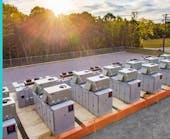Electric power markets in the United States are undergoing significant structural change the Energy Information Administration (EIA) believes, based on planning data EIA collects, will result in the installation of the ability of large-scale battery storage to contribute 10,000 MW to the grid between 2021 and 2023—10 times the capacity in 2019.
Energy storage plays a pivotal role in enabling power grids to function with more flexibility and resilience. In this report, EIA provides data on trends in battery storage capacity installations in the United States through 2019, including information on installation size, type, location, applications, costs, and market and policy drivers. The report then briefly describes other types of energy storage.
This report focuses on data from EIA survey respondents and does not attempt to provide rigorous economic or scenario analysis of the reasons for, or impacts of, the growth in large-scale battery storage.
Growth across U.S. electric power market regions
The number and total capacity of large-scale battery storage systems continue to grow in the United States, and regional patterns strongly influence the nation-wide market structure:
- At the end of 2019, 163 large-scale battery storage systems were operating in the United States, a 28% increase from 2018. The maximum energy that could be stored at these sites (energy capacity) was 1688 MWh, and the maximum power that could be provided to the grid from these sites at any given moment (power capacity) was 1022 MW.
- As of the end of 2019, more than 60% of the large-scale battery system capacity to store energy or provide power to the grid in the United States was located in areas covered by regional grid operators PJM Interconnection (PJM) and California Independent System Operator (CAISO). Historically, these areas attracted capacity additions because of favorable market rules promoting energy storage.
- Starting in 2017, regions outside of PJM and CAISO have also seen installations of large-scale battery energy storage systems, in part as a result of declining costs.
Small-scale battery storage
Small-scale battery storage also continues to grow, especially in California, but also in other regions of the United States:
- In 2019, 402 MW of small-scale total battery storage power capacity existed in the United States.
- California accounts for 83% of all small-scale battery storage power capacity.
- The states with the most small-scale power capacity outside of California include Hawaii, Vermont, and Texas.
Lower installed costs
The costs of installing and operating large-scale battery storage systems in the United States have declined in recent years.
- Average battery energy storage capital costs in 2019 were US$589/kWh, and battery storage costs fell by 72% between 2015 and 2019, a 27% per year rate of decline.
- These lower costs support more capacity to store energy at each storage facility, which can increase the duration that each battery system can last when operating at its maximum power.
More direct support from solar power
Most large-scale battery energy storage systems EIA expects to come online in the United States over the next three years are to be built at power plants that also produce electricity from solar photovoltaics, a change in trend from recent years.
- As of December 2020, the majority of U.S. large-scale battery storage systems were built as standalone facilities, meaning they were not located at sites that generate power from natural resources. Only 38% of the total capacity to generate power from large-scale battery storage sites was co-located with other generators: 30% was co-located specifically with generation from renewable resources, such as wind or solar PV, and 8% was co-located with fossil fuel generators.
- EIA expects the relationship between solar energy and battery storage to change in the United States over the next three years because most planned upcoming projects will be co-located with generation, in particular with solar facilities. If all currently announced projects from 2021 to 2023 become operational, then the share of U.S. battery storage that is co-located with generation would increase from 30% to 60%.
Additional accelerated growth
Based on planning data EIA collects, an additional 10,000 MW of large-scale battery storage’s ability to contribute electricity to the grid is likely to be installed between 2021 and 2023 in the United States—10 times the total amount of maximum generation capacity by all systems in 2019 (Figure ES4).
Almost one-third of U.S. large-scale battery storage additions will come from states outside of regional grid operators PJM and CAISO, which led in initial development of large-scale battery capacity.





